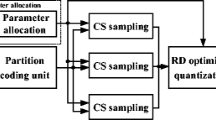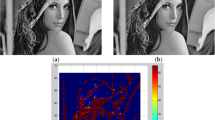Abstract
Compressive sensing (CS) is an emerging technology which samples a sparse signal at a rate corresponding to its actual information content rather than to its bandwidth. The encoding scheme based on CS features low hardware complexity and power consumption. It is widely used in resource-limited application where the energy consumption determines the lifetime of the system. In this paper, the primary concern is how to configure the encoder to achieve the target energy consumption and target bit rate as well as the optimal picture quality. Firstly, the rate–distortion (R–D) behavior is investigated under the energy constraint. Then a source rate–distortion model and energy consuming model are proposed to quantify the relationship among coding parameters, source encoding rate, distortion, and energy consumption. The accuracy is verified through the experiments. Since the proposed models provide a theoretical basis and a practical guideline for performance optimization, the optimal configuration of coding parameters can be determined. The coding system adjusts its parameter configuration to match the available energy supply of the system while maximizing the picture quality. Simulation results have demonstrated the effectiveness of the proposed approach in achieving the optimal image quality and energy efficiency.














Similar content being viewed by others
References
Donoho, D.: Compressive sensing. IEEE Trans. Inf. Theory 52, 1289–1306 (2006)
Candès, E., Romberg, J., Tao, T.: Exact signal reconstruction from highly incomplete frequency information. IEEE Trans. Inf. Theory 52, 489–509 (2006)
Wu, X.L., Zhang, X.J.: Model-guided adaptive recovery of compressive sensing. In: Proceedings on Data Compression Conference, pp. 123–132 (2009)
Goyal, V.K., Fletcher, A.K., Rangan, S.: Compressive sensing and lossy compression. IEEE Signal Process. Mag. 25, 48–52 (2008)
He, Z.H., Liang, Y.F., Chen, L.L., Ahmad, I., Wu, D.P.: Power–rate–distortion analysis for wireless video communication under energy constraints. IEEE Trans. Circuits Syst. Video Technol. 15, 645–658 (2005)
Kang, L.W., Lu, C.S., Lin, C.Y.: Low-complexity video coding via power–rate–distortion optimization. J. Vis. Commun. Image Represent. 23, 569–585 (2012)
Schulz, A., Velho, L., Silva, E.D.: On the empirical rate–distortion performance of compressive sensing. In: IEEE International Conference on Image Processing, pp. 3049–3052 (2009)
Li, C.L., Wu, D.P.: Delay–power–rate–distortion model for wireless video communication under delay and energy constraints. IEEE Trans. Circuits Syst. Video Technol. 24, 1170–1183 (2014)
He, Z., Cheng, W., Chen, X.: Energy minimization of portable video communication devices based on power–rate–distortion optimization. IEEE Trans. Circuits Syst. Video Technol. 18, 596–608 (2008)
He, Z., Liang, Y., Chen, L., Ahmad, I., Wu, D.: Power–rate–distortion analysis for wireless video communication under energy constraints. IEEE Trans. Circuits Syst. Video Technol. 15, 645–658 (2005)
He, Z., Wu, D.: Resource allocation and performance analysis of wireless video sensors. IEEE Trans. Circuits Syst. Video Technol. 16, 590–599 (2006)
Lian, C.J., Chien, S.Y., Lin, C.P., Tseng, P.C., Chen, L.G.: Power-aware multimedia: concepts and design perspectives. IEEE Circuits Syst. Mag. 7, 26–34 (2007)
Hemalatha, R., Radha, S., Sudharsan, S.: Energy-efficient image transmission in wireless multimedia sensor networks using block-based compressive sensing. Comput. Electr. Eng. 44, 67–79 (2015)
Pudlewski, S., Melodia, T.: A rate–energy–distortion analysis for compressed-sensing-enabled wireless video streaming on multimedia sensors. In: IEEE Globecom, pp. 1–6 (2011)
pudlewski, S., Melodia, T.: compressive video compression: design and rate–energy–distortion analysis. IEEE Trans. Multimed. 15, 2072–2086 (2013)
Bellasi, D.E., Benini, L.: Energy-efficiency analysis of analog and digital compressive sensing in wireless sensors. IEEE Circuits Syst. Mag. 62, 2718–2729 (2015)
Ramchandran, K., Vetterli, M.: Best wavelet packet bases in a rate–distortion sense. IEEE Trans. Image Process. 2, 160–175 (1993)
Jiang, W.: A novel algorithm of solving the optimal slope on rate–distortion curve for the given rate budget. J. Donghua Univ. 26, 259–263 (2009)
Liu, H.X., Song, B., Tian, F., Qin, H.: Joint sampling rate and bit-depth optimization in compressive video sampling. IEEE Trans. Multimed. 16, 1549–1562 (2014)
Noise, E.: The restricted isometry property and its implications for compressed sensing. C. R. Math. 346, 589–592 (2008)
Candes, E., Wakin, M.: An introduction to compressive sampling. IEEE Signal Process. Mag. 25, 21–30 (2008)
Do, T.T., Gan, L., Nguyen, N., Tran, T.D.: Sparsity adaptive matching pursuit algorithm for practical compressed sensing. In: Asilomar Conference on Signals, Systems and Computers, pp. 581–587 (2008)
Donoho, D.L., Tsaig, Y., Drori, I., luc Starck, J.: Sparse solution of underdetermined linear equations by stage wise orthogonal matching pursuit. IEEE Trans. Inf. Theory 58, 1094–1121 (2012)
Needell, D., Tropp, A.: Cosamp: iterative signal recovery from incomplete and inaccurate samples. Appl. Comput. Harmon. Anal. 26, 301–321 (2009)
Gunturk, C.S., Lammers, M., Powell, A., Saab, R., Yilmaz, O.: Sigma delta quantization for compressed sensing. In: Proceedings of the 44th Annual Conference on Information Sciences and Systems, pp. 1–6 (2010)
Candes, E., Romberg, J.: Encoding the lp Ball from limited measurements. In: Proceedings of the Data Compression Conference (DCC), pp. 1–10 (2006)
Dunkels, A., Eriksson, J., Finne, N., Tsiftes, N.: Powertrace: network-level power profiling for low-power wireless networks. Swed. Inst. Comput. Sci. 5, 1–14 (2011)
Lee, D.U., Kim, H., Tu, S., Rahimi, M., Estrin, D., Villasenor, J.: Energy-optimized image communication on resource constrained sensor platforms. http://escholarship.org/uc/item/5vg6h5n0#page-3. Accessed 11 Sept 2017
Wang, H., Peng, D., Wang, W., Sharif, H., Chen, H.H.: Cross-layer routing optimization in multirate wireless sensor networks for distributed source coding based applications. IEEE Trans. Wirel. Commun. 7, 3999–4009 (2008)
Shoham, Y., Gersho, A.: Efficient bit allocation for an arbitrary set of quantizers (speech coding). IEEE Trans. Acoust. Speech Signal Process. 36, 1445–1453 (1988)
Wu, X., Dong, W., Zhang, X., Shi, G.: Model-assisted adaptive recovery of compressed sensing with imaging applications. IEEE Trans. Image Process. 21, 451–458 (2012)
Acknowledgements
This paper was supported by National Natural Science Foundation of China (61401269,61572311), Shanghai Technology Innovation Shanghai Technology Innovation Project (17020500900), Foundation of Shanghai Talent Development (201501), and “Shuguang Program” sponsored by Shanghai Education Development Foundation and Shanghai Municipal Education Commission (17SG51), Local colleges and universities capacity building Program (14110500900, 15110500900).
Author information
Authors and Affiliations
Corresponding author
Rights and permissions
About this article
Cite this article
Jiang, W., Yang, J. Energy-constraint rate distortion optimization for compressive sensing-based image coding. SIViP 12, 1419–1427 (2018). https://doi.org/10.1007/s11760-018-1297-6
Received:
Revised:
Accepted:
Published:
Issue Date:
DOI: https://doi.org/10.1007/s11760-018-1297-6




